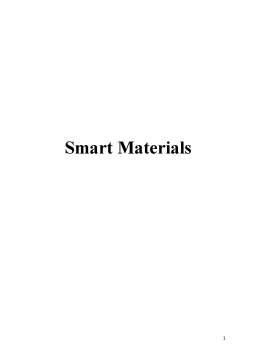Cuprins
- 1.Theoretical support
- 1.1. Ferroelectricity
- 1.2. Piezoelectricity
- 2.Piezoelectric materials
- 2.1. Quartz
- 2.2. Barium titanate
- 3.Applications
- 3.1. Watches
- 3.2. Printing
- 3.3. Sensors
Extras din referat
Smart materials are materials which respond to enviormental stimuli with particular changes in some of its variables. Smart or intelligent materials are the group of new materials which are being developed at the moment. Their engineering applications are very diverse. The focus of this project are the piezoelectric materials, a subgroup of the enormous field of smart materials.
1.Theoretical support
1.1. Feroelectricity
Ferroelectricity is a property of certain materials that have a spontaneous electric polarization that can be reversed by the application of an external electric field. The term is used in analogy to ferromagnetism, in which a material exhibits a permanent magnetic moment.
Ferroelectric materials--for example, barium titanate (BaTiO3) and Rochelle salt--are composed of crystals in which the structural units are tiny electric dipoles; that is, in each unit the centres of positive charge and of negative charge are slightly separated.
1.2. Piezoelectricity
Ferroelectric materials can also be piezoelectric, the crystalline structure allows the following phenomenon to take place. Piezoelectricity is the electric charge that accumulates in certain solid materials in response to applied mechanical stress. The word piezoelectricity means electricity resulting from pressure. It is derived from the Greek piezo which means to squeeze or press, hence the original meaning of the word piezoelectricity was 'pressure electricity'.
One of the unique characteristics of the piezoelectric effect is that it is reversible. When mechanical pressure is applied to a piezoelectric material, the crystalline structure produces a voltage proportional to the pressure. Conversely, when a piezoelectric material is subjected to an electric field, the structure changes in shape, producing dimensional changes in the material.
You've probably used piezoelectricity quite a few times today. If you've got a quartz watch, piezoelectricity is what helps it keep regular time. If you've been writing a letter or an essay on your computer with the help of voice recognition software, the microphone you spoke into probably used piezoelectricity to turn the sound energy in your voice into electrical signals your computer could interpret. If you're a bit of an audiophile and like listening to music on vinyl, your gramophone would have been using piezoelectricity to "read" the sounds from your LP records. Piezoelectricity (literally, "pressing electricity") is much simpler than it sounds: it just means using crystals to convert mechanical energy into electricity or vice-versa.
Piezoelectric crystals have been used for many years as transducers for converting mechanical to electrical energy, and vice versa. Applications are diverse, e.g. as bimorphs in microphones, earphones, loudspeakers and stereo pick-ups; as fuses, solenoid ignition systems and cigarette lighters, sonar generators and ultrasonic cleaners. More complex devices are used in transformers, filters and oscillators.
2. Piezoelectric materials
2.1. Quartz
Quartz is the second most abundant mineral in the Earth's continental crust, after feldspar. It is made up of a continuous framework of SiO4 silicon - oxygen tetrahedra, with each oxygen being shared between two tetrahedra, giving an overall formula SiO2.
There are many different varieties of quartz, several of which are semi-precious gemstones. Especially in Europe and the Middle East, varieties of quartz have been since antiquity the most commonly used minerals in the making of jewelry and hardstone carvings.
Pure quartz, traditionally called rock crystal (sometimes called clear quartz), is colorless and transparent (clear) or translucent, and has often been used for hardstone carvings, such as the Lothair Crystal. Common colored varieties include citrine, rose quartz, amethyst, smoky quartz, milky quartz, and others.
Quartz belongs to the trigonal crystal system. The ideal crystal shape is a six-sided prism terminating with six-sided pyramids at each end. In nature quartz crystals are often twinned, distorted, or so intergrown with adjacent crystals of quartz or other minerals as to only show part of this shape, or to lack obvious crystal faces altogether and appear massive. Well-formed crystals typically form in a 'bed' that has unconstrained growth into a void; usually the crystals are attached at the other end to a matrix and only one termination pyramid is present. However doubly-terminated crystals do occur where they develop freely without attachment, for instance within gypsum. A quartz geode is such a situation where the void is approximately spherical in shape, lined with a bed of crystals pointing inward.
Bibliografie
- Solid State Chemistry and its Applications, 2nd Edition, Student Edition - Anthony R. West
- Piezoelectric Materials, NEC/TOKIN, 8th Edition
- Piezoelectric Sensorics - Gustav Gautschi
- http://www.livescience.com/32509-why-is-quartz-used-in-watches.html
- http://en.wikipedia.org/wiki/Quartz_clock
- http://en.wikipedia.org/wiki/Micro_Piezo
- http://en.wikipedia.org/wiki/Piezoelectric_sensor
- https://www.americanpiezo.com/piezo-theory/piezo-sensor-applications.html
- http://www.nanomotion.com/piezo-ceramic-motor-technology/piezoelectric-effect/
- http://www.explainthatstuff.com/piezoelectricity.html
- http://en.wikipedia.org/wiki/Ferroelectricity
- http://www.britannica.com/EBchecked/topic/205124/ferroelectricity
- http://global.kyocera.com/fcworld/charact/elect/piezo.html
Preview document
Conținut arhivă zip
- Smart materials.docx


















